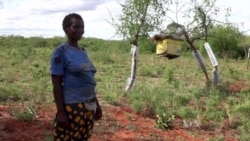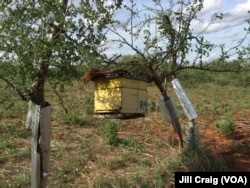African elephants are the largest land animals on Earth, weighing as much as six tons, and measuring up to 7.5 meters long.
But despite their size, they find humans to be their greatest threat: Tens of thousands of these animals are killed every year for their ivory tusks.
Researcher Lucy King, head of the human-elephant coexistence program at Kenya-based conservation group Save the Elephants, said poaching is devastating animal populations across Africa.
But another major concern is human-wildlife conflict.
When elephants raid crops, it causes financial loss to the farmers and potential harm to the elephants.
'Increasing exponentially'
“The population in Africa is increasing exponentially, and the land space for elephants and other large game is shrinking exponentially,” King said. “Corridors are being blocked, infrastructure development is coming up, and so I believe the next big challenge for elephants is going to be conflict.
"And that interface between farmers and elephants is the one we’re working on, and we feel we can do something with," she said.
So she did.
King learned that when elephants heard the distinctive sound of bees, they rounded up their herd and quickly moved away.
Local farmers attested that despite the elephants’ thick skin, bees could still sting around their eyes and disturb their ears, causing them to shy away when they heard buzzing.
And the Elephants and Bees Project was born.
King and her team work near in the Taita-Taveta area of Kenya, near Tsavo East National Park, where they’ve helped 22 farmers build and maintain beehive fences, consisting of between 10 and 21 hives, depending on the size of the farmer’s plot, plus “dummy” hives to help spread out the bee concentration.
Deterrent
The hives are strung along the periphery of a farmer’s crops to deter the elephants from crop raiding.
The team monitors each farmer’s hives carefully, taking notes on each one and also working with the farmers to determine the elephants’ movements in the area.
King says a beehive fence features a critical difference from an electric fence.
“Electric fencing provides a shock to the body, but it’s static. So the elephants can learn, 'If I touch that, it’s going to hurt.' But they can test it, they can put their bodies against it, they can push their feet on the posts, and eventually they can work out, one quick shove and the fence will go down,” King said. “But the fence doesn’t chase them afterwards.”
Local farmer Charity Mwangome, who built her fence in 2012, believes the research buzz.
“It helps a lot because if the elephants come in and they see the fence, they stop and don’t come into the farm. They instead go around," Mwangome said.
But the beehive fence, which King said has about an 80 percent success rate, doesn’t just help with keeping out the elephants. It also provides farmers with another means to generate income, through honey production.
WATCH: Video clip of elephants
Boost to income
And for farmers who make on average $300 per year, less than a dollar a day, the 30 to 50 percent income boost makes a big difference.
Research center coordinator Matthew Rudolph said the biggest problem is just keeping up with consumer demand for the honey, which he and other staff members process at its center here.
“People pick it up as soon as it is jarred,” Rudolph said.
And it goes fast, Rudolph and King said.
The center typically harvests the honey twice a year -- in January and May -- and produces about 500 jars. However, requests worldwide far exceed the production, the researchers said.
King said the priority is to first supply local markets so word about the beehive fences will spread.
An open-source manual for constructing a beehive fence can be found on the group’s website.
King said she has received comments from people in at least 11 African and Asian countries who have used the plans to build their own beehives, adapting them to local conditions.
Poaching issue
Although this project helps combat human-wildlife conflict, poaching remains the No. 1 threat to elephants.
Kenya President Uhuru Kenyatta will host this month’s Giants Club Summit, which will bring dignitaries together at Mount Kenya to find solutions to combat the crisis.
Organizers expect presidents from four African countries -- Botswana, Gabon, Kenya and Uganda -- and their representatives to attend the event, to be held Thursday through Saturday.
The event will conclude in Nairobi Saturday with the destruction of 105 tons of seized ivory to prevent its economic use.
PHOTO GALLERY: Related Elephant and Bee Project photos















